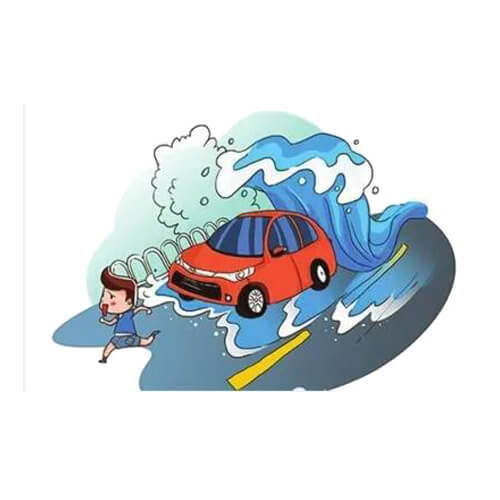Long-term rainfall and melting snow have raised water levels and flooded city roads, causing flooding. Frequent and extreme flooding is inevitable and endangers community safety. Areas that are low-lying or near rivers and lakes are more vulnerable to flooding than normal areas. To reduce hazards from flooding, a flood warning system should be in place near any major waterway. Flood warning systems can help communities and transportation prepare for this serious threat. Timely and accurate early warning can save property and lives.
All countries in the world attach great importance to flood warning systems. In 1854, France established the world’s first flood warning system on the Seine River. In 1966, the United States used remote sensing technology to improve data collection and processing methods in the Mississippi River flood control project. Many developed countries have established automatic flood warning systems on many rivers. Some developing countries have also established such systems on some rivers.
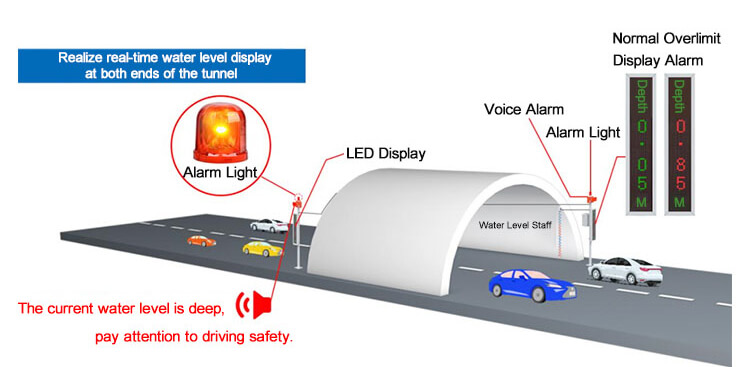
What is a flood warning system?
The flood warning system monitors and warns of changes in water levels, prevents flooding caused by extreme weather and utilizes water resources efficiently. It allows for data monitoring, transmission, processing and analysis.
The flood warning system utilizes computer technology, database technology, communication technology, and sensor technology. Powered by IoT technology, rainfall and water levels are monitored and floods are predicted. Early warning of impending flooding can save lives and reduce extensive property damage. Predict potential flood disasters and provide scientific information for effectively preventing flood disasters.
The real time flood monitoring and warning system include liquid level sensors, meteorological sensors, communication equipment, and data collectors. And data acquisition, archiving, processing, and management software designed for flood warnings.
How do flood warning systems work?
Monitoring of river rainfall, water level and flow velocity at important measuring points upstream. The monitoring data is transmitted to the software platform through wired or wireless signals. After data processing and analysis, the flood dynamics can be grasped in time, and the mathematical model can be used to make future coastal flood forecasts. Provide enough time for the community or transit station to take action. Reduce property and life loss.
Two types of flood warning systems
There are many automated flood monitoring system types. The functions that can be realized vary from system to system. The number of stations, their location, and the hydrological sensors used at each station differ from region to region. If you want to monitor low-lying roads, a waterlogged sensor is best. If you want to monitor changes in a nearby river, water level staff and level sensors are the way to go.
Road flood warning system
The road flood alarm system is a device that buries the water sensor on the ground to monitor the groundwater depth. Once the water depth exceeds the set value, the alarm will be used to remind the staff to drain water in time and remind pedestrians to pay attention to the water depth. The station adopts highly integrated equipment to monitor the water accumulation in various low-lying road sections in the urban area in real time and realize automatic alarms. By integrating data from various monitoring points, we can know the waterlogging status for the entire urban area and carry out drainage scheduling in a timely manner.
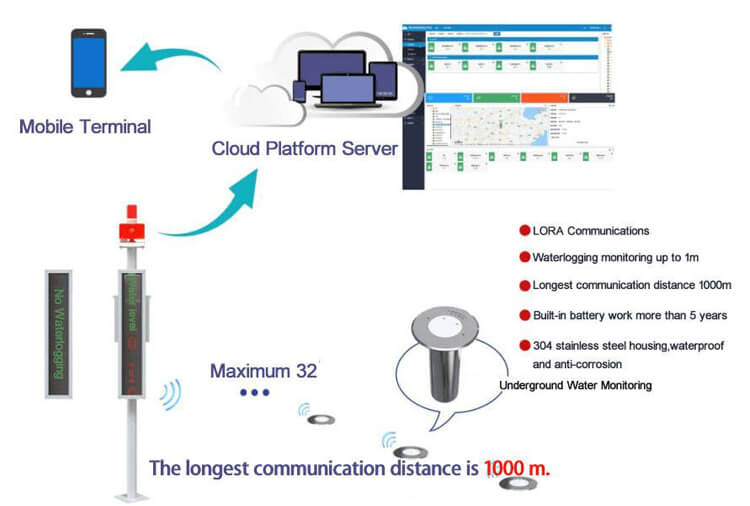
The road flood alarm system is usually installed in low terrain locations, such as bridge holes, underpasses, low-lying intersections, overpasses, tunnels and other places to protect the safety of people’s access. It can also be installed in places such as irrigation canals, rivers, underground drainage outlets, etc. to protect the drainage safety of the city. Or it can be installed in underground garage to protect people’s property safety.
System composition
The road flood monitoring station includes LORA buried water sensor, rain gauge, monitoring master station (including LED display, horn, alarm, telemetry, waterproof box, 2m pole, etc.) and a comprehensive environmental monitoring cloud platform.
LORA buried water sensor: It is a measuring unit with a 304 stainless steel shell. Built-in water level detection module (water depth, water status), Bluetooth configuration module, LORA wireless communication module and built-in lithium battery. Its principle is based on the liquid-mediated ultrasonic sensor. Measure the duration of the sound wave from emission to reception, and combine the compensated sound velocity to obtain the distance traveled by the sound wave. Calculate the current liquid level height according to the time difference from the time the ultrasonic waves are emitted to the water surface echoes are received from the installed measuring points.
Rain gauge: The tipping bucket rain gauge is most commonly used in flood monitoring stations, which has high measurement accuracy and is easy to install. It can be used in an outdoor environment for a long time. It is usually installed on top to avoid surrounding objects from blocking rainwater from falling. The rain gauge is used to measure the rainfall in the current environment and provide data support for the flood warning system.
LCD display screen: 102cm*22cm LED red and green dual-color display screen, the unit board dot matrix is 16*96, and the display mode is the vertical display. It is convenient for pedestrians and vehicles to see the depth in tunnels, highways, and other places.
Speaker and alarm: Neither the alarm nor the speaker will work when the water level does not exceed the set limit. When the limit is exceeded, the speaker works, the broadcast content is consistent with the display content, and the alarm works at the same time. Once the limit is exceeded, the alarm and the speaker broadcast three times, and after three times, it is judged whether the limit is exceeded. The interval between each broadcast is fixed at 5S.
Telemetry: It is inside the waterproof box. It is a transfer server developed by our company that is suitable for remote monitoring equipment and transmits data through the 4G communication module. The water level value and remaining power can be uploaded in real time through 4G or RJ45.
Waterproof box: The waterproof box is mainly used to protect important electrical components from rain damage. It adopts a high-strength sheet metal box and a white plastic-sprayed anti-rust shell. Resistant to long-term rain and snow, and solar radiation. It can work outdoors for a long time. Even under direct sunlight, it can ensure a constant temperature inside the box.
Pole: It is high-strength stainless steel, which mainly plays a supporting role.
Data Platform: The Flood Monitoring Station includes a robust and reliable network data collection and management software platform to facilitate 24×7 enabled real-time monitoring, visualization and web-based decision management. Every important parameter on the project can be monitored and managed in real time. At the same time realize platform-based remote control. Data platforms can view trends in real time or in graph form. Real-time alerts can be sent via text or email when measured data exceeds set values.
Advantages
One telemetry in this flood monitoring system can be connected to 32 water sensors, and can collect water level information from 32 different locations at the same time. The measurement range is very wide. The "one-to-many supervision model" allows us to monitor various locations in the city in real time.
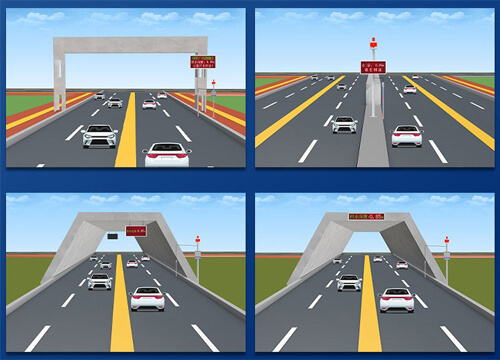
In the past, in order to detect the water level in different places, we always ran here and there. Now, the measuring point is at this end, and the terminal display is at that end. LoRa wireless transmission, no wiring problem. The LoRa signal has strong penetrating ability, and the distance can reach up to 1000 meters.
The sensors at the site can be configured via Bluetooth. We just use the magnet to rotate 3 times or more clockwise around the teflon, click the software to connect the device. Connect the upper measuring point, modify the transmission frequency, reception frequency, transmission/reception spreading factor, data upload interval, system time, water immersion threshold and other parameters. You can also view real-time water level data.
Telemetry will upload water level information and battery power to the monitoring platform, so that customers can view the data on their mobile phones or computers anytime, anywhere. The monitoring platform has powerful functions, real-time data, remote alarm, historical data export, parameter setting, map viewing, etc. You can also view the scene through video. In addition, it also has functions such as large-screen visualization, account authority classification, information sharing, manual, timing, and automatic control.
The safety thresholds can be set separately on the sensor and the monitoring platform. When the accumulated water at the measuring point exceeds the set safety value, the alarm function will be automatically turned on. On-site: The font on the LED two-color display turns red, and the current water level is displayed in real time. Sound and light alarms and loudspeakers will remind passing pedestrians to pay attention to safety. On the monitoring platform: the monitoring interface will alarm with redness, pop-up window, sound, etc. Remotely send alarms to us by email, text message, phone call, etc. Confirm the specific location through the electronic map so that we can make timely countermeasures and reduce losses.
River flood warning system
This flood warning system is used to measure changes in the water level of rivers and water bodies to predict flood damage. This flood alarm system has protective measures such as lightning protection and anti-jamming. Various technologies such as derating, electromagnetic compatibility, and outlier elimination are adopted. Enhance the resistance of the monitoring station to the field environment, making it more adaptable to various harsh environments in the field.
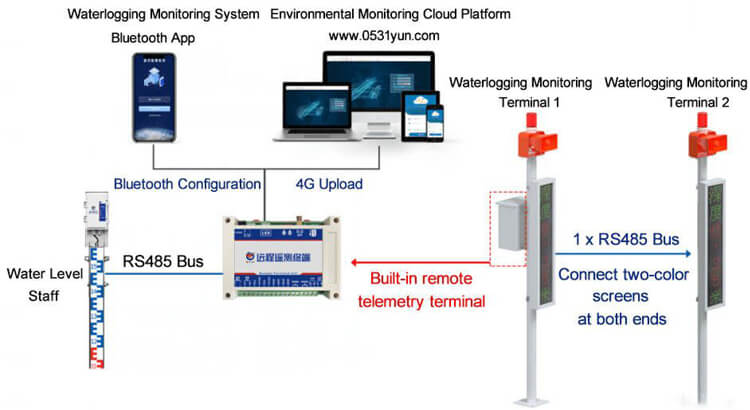
System composition
The river flood monitoring station includes a level staff, a two-color LED display, a waterproof box (including telemetry), an alarm light, a horn, a two-meter pole, and a solar power supply system (optional). Among them, the water level staff transmits the measured water level information to the telemetry through rs485 communication. Telemetry transmits the water level value to the background server through the 4G communication module. At the same time, the detected water level can be displayed on the LED screen in real-time, and the horn and alarm will be triggered if the water level exceeds the limit. Remind the staff to arrange flood control work in time.
Water level staff: Adopt an advanced processor chip as a controller. The range supports customization, and the data is obtained by measuring the water level, which has extremely high precision and anti-interference ability. Various working modes can be modified according to the site conditions. The casing adopts advanced production technology, and stainless steel is used as the casing protection material. The interior is specially treated with high-sealing materials so that the product is not affected by the external environment such as mud, corrosive liquid, pollutants, and sediment.
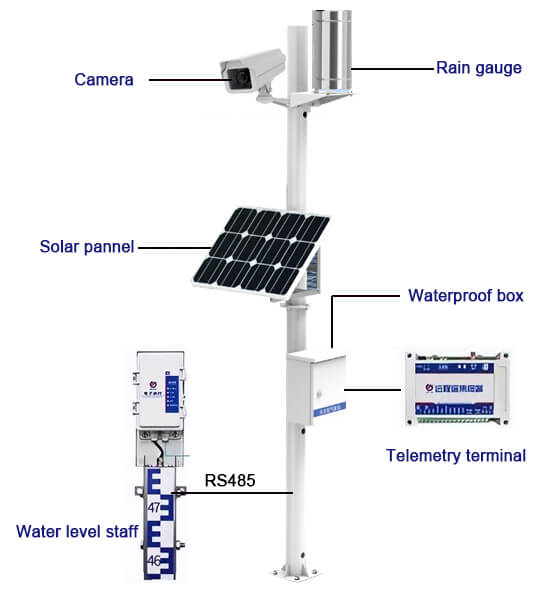
Rain gauge: Used to monitor the effect of rainfall on water level changes.
Solar panels and storage batteries: Monitoring sites are mostly installed in mountainous areas with complex terrains, far away from the grid and need to be powered by cables. Installing solar panels does not require laying complicated wires. It is quick to install and can be installed and used at any time, which not only provides convenience but also saves costs. So solar power becomes the best choice. When the battery is fully charged, the site can be guaranteed to work continuously for 7 days in rainy days.
Telemetry: It is inside the waterproof case and is used for data transmission.
Waterproof box: used to protect telemetry, monitoring host and other non-waterproof electrical components.
Pole: The micro-connecting hole design is added to the pole body, and the wiring is inside the pole. Effectively avoid damage to equipment lines caused by ultraviolet rays and birds and insects. There is an inspection port on the rod body, which is not only convenient for inspection and maintenance, but also convenient for configuration.
Optional camera: In order to understand the changes in the water around the site, the flood monitoring station can be equipped with an optional Haikang camera, and the monitoring screen can be uploaded to the data platform through the network character superimposed device, and the environment can be monitored by video.
Software platform: The river flood monitoring station can be configured not only through the remote cloud platform, but also through the on-site Bluetooth connection APP configuration. Upload target address, target port, water level deviation, water level threshold, water level hysteresis, delay time, data upload interval, ICCID value, etc.
The importance of flood warning systems
Flood monitoring is to prevent floods from harming the environment. Flood alarm stations are set up to provide real-time data on rivers, lakes, reservoirs or other water bodies. Flood warning systems can provide real-time water regime data to workers to take action before flood disasters occur to prevent loss of property and lives.
According to the law of flood formation and movement. Use real-time hydrological and meteorological data to predict future flood development. Water workers and ambulance crews must know when flooding is expected, where it is likely to go, and how severe it will be. Only in this way can the community be protected to the greatest extent.
A real-time flood warning system can predict flood occurrence, direction and severity. Empowering communities to respond faster and more effectively so they can protect their own citizens. Accurate forecasts and effective measures are the best defenses against floods as they allow for more informed decisions.
Flood warning systems advantages
Alarm is accurate
The monitoring platform intelligently analyzes the measurement video and data, and excludes climate and environmental factors. Avoid manual monitoring errors and reduce false positives and false negatives in the video surveillance system.
Real-time alarm
Using intelligent video analysis and network technology to measure the lake in real time, the alarm information can be displayed on the monitoring client interface, and the alarm information can also be pushed to the mobile terminal.
Long-term monitoring
The flood monitoring system is often designed to withstand inclement weather, ensuring accurate measurements even when working outdoors for long periods of time. Maintenance is minimal, greatly reducing labor costs.
Storage function
Record the water level changes at monitoring points in real time, and store the alarm information in the server database, including time, location, snapshot, video, etc.

